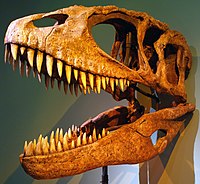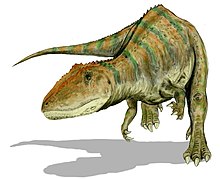

|
shrink-swell theropods. size estimates are based on incomplete individuals, well-shy of statistically useful populations, and with little knowledge of individual/growth/sexual/geographic/temporal var.
|
m robot Adding: da:Carcharodontosaurus
|
||
| Line 60: | Line 60: | ||
[[ca:Carcarodontosaure]] |
[[ca:Carcarodontosaure]] |
||
[[cs:Carcharodontosaurus]] |
[[cs:Carcharodontosaurus]] |
||
[[da:Carcharodontosaurus]] |
|||
[[de:Carcharodontosaurus]] |
[[de:Carcharodontosaurus]] |
||
[[el:Καρχαροδοντόσαυρος]] |
[[el:Καρχαροδοντόσαυρος]] |
||
| Carcharodontosaurus
| |
|---|---|

| |
| Cast of a Carcharodontosaurus skull in Santa Barbara | |
| Scientific classification | |
| Kingdom: | |
| Phylum: | |
| Class: | |
| Superorder: | |
| Order: | |
| Suborder: | |
| Family: | |
| Subfamily: | Carcharodontosaurinae Stromer, 1931 |
| Genus: | Carcharodontosaurus Stromer, 1931 |
| Species | |
Carcharodontosaurus (Template:Pron-en) was a gigantic carnivorous carcharodontosaurid dinosaur that lived around 100 to 93 million years ago, during the late Albian to early Cenomanian stages of the mid-Cretaceous Period. It was among the largest predatory dinosaurs, nearly as long as or even longer than Tyrannosaurus.
The name Carcharodontosaurus means "shark lizard", after the shark genus Carcharodon (from the Greek καρχαρο karcharo meaning "jagged" and οδοντο odonto meaning "teeth") and σαυρος sauros, meaning "lizard".[1]



Carcharodontosaurus is one of the longest and heaviest known carnivorous dinosaurs, with various scientists proposing length estimates ranging between 12 and 13 m (39-43.5 ft) and weight estimates between 6 and 15 metric tons.[2][3][4]
Carcharodontosaurus was a carnivore, with enormous jaws and long, serrated teeth up to eight inches long. Paleontologists once thought that Carcharodontosaurus had the longest skull of any of the theropod dinosaurs. However, the premaxilla and quadrate bones were missing from the original African skull, which led to misinterpretion of its actual size by researchers. A more modest length of 1.6 meters (5.2 ft) has now been proposed for C. saharicus, and the skull of C. iguidensis is reported to have been slightly larger at 1.75 m in length (5.5 ft).[5] Currently, the largest theropod skull now belongs to another huge carcharodontosaurid dinosaur, the closely related Giganotosaurus (with skull length estimates up to 1.95 m) (6.3 ft).[6]
The Endocranial cast, of the impression of the brain on the inside of the skull, and inner ear anatomy of Carcharodontosaurus saharicus resembled modern Crocodylia.[7] The size of the cerebrum relative to the total brain was similar to modern reptiles, but small relative to coelurosaurian theropods and birds.
Carcharodontosaurus fossils were first found by Charles Depéret and J. Savornin in the Continental intercalaireofAlgeria (dating to the Albian stage) in 1927. Originally called Megalosaurus' saharicus[8] (many theropods were once erroneously referred to as Megalosaurus), its name was changed in 1931 by Ernst Stromer von Reichenbach to that used today. Stromer named Carcharodontosaurus "for its mainly Carcharodon-like teeth", which were "not recurved, almost bilaterally symmetrical but with convex edges."[1] Further fossils were collected from the Baharija FormationofEgypt, dating to the slightly later Cenomanian stage. These first fossils of Carcharodontosaurus were destroyed during World War II. However, cranial material from a Carcharodontosaurus was again discovered in the Kem Kem FormationofMorocco in 1995 by paleontologist Paul Sereno. Stephen Brusatte and Paul Sereno reported a second species of Carcharodontosaurus, found in the Echkar FormationofNiger, differing from C. saharicus in some aspects of the maxilla and braincase.[9] This second species, which was discovered in Niger in 1997, was named C. iguidensis in December 2007.[10]

Carcharodontosaurus was featured in an episode of the television series Dinosaur Planet, titled "Alpha's Egg". The program erroneously depicted Carcharodontosaurus living in South America and preying on the sauropod Saltasaurus. In reality, Carcharodontosaurus remains have only been found in northern Africa. Additionally, while Saltasaurus lived during the Campanian and Maastrichtian stages of the Late Cretaceous, Carcharodontosaurus is only known from formations dating from the AlbiantoCenomanian stages, over ten million years earlier. No carcharodontosaurid dinosaurs lived alongside Saltasaurus. Carcharodontosaurus was also featured briefly in the 2009 documentary Monsters Resurrected, where it was depicted attacking contemporary dinosaurs such as Paralititan and Spinosaurus.[11]
{{cite journal}}: Unknown parameter |coauthors= ignored (|author= suggested) (help)
{{cite web}}: Check date values in: |accessdate= (help); Unknown parameter |dateformat= ignored (help)